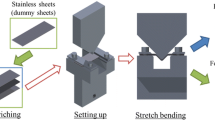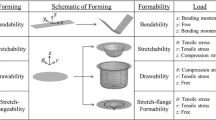Abstract
A new method for designing carbon-fiber-reinforced plastic (CFRP) sheets with a suitable ply structure for stamping is proposed. This method combines a generic algorithm with a three-dimensional finite element method (FEM) to reproduce a layered structure by homogenizing the fiber structure with elastic-plastic anisotropy of each layer. The maximum strain is used as a fracture index to evaluate the severity of sheet deformation under stamping. The ply structure of the CFRP is optimized for elliptic cup drawing, and the optimized ply structure is validated experimentally. Through the experimental validation, it is proven that the proposed method gives acceptable results for the optimization of the ply structure of thermosetting CFRP sheets for cold/warm stamping.










Similar content being viewed by others
References
Goto K, Hatta H, Katsu D, Machida T (2003) Tensile fatigue of a laminated carbon-carbon composite at room temperature. Carbon 41(6):1249–1255
Sharma M, Rao IM, Bijwe J (2009) Influence of orientation of long fibers in carbon fiber-polyetherimide composites on mechanical and tribological properties. Wear 267(5–8):839–845
Teti R (2002) Machining of composite materials. CIRP Ann Manuf Technol 51(2):611–634
Franke V (2011) Drilling of long fiber reinforced thermoplastics - influence of the cutting edge on the machining results. CIRP Ann Manuf Technol 60(1):65–68
Schulze V, Becke C, Pabst R (2011) Specific machining forces and resultant force vectors for machining of reinforced plastics. CIRP Ann Manuf Technol 60(1):69–72
Lange S, Schmidt H, Seliger G (2000) Product and assembly design for a fibre reinforced plastic track wheel. CIRP Ann Manuf Technol 49(1):105–108
BOEING 787 “Dreamliner” Advanced Composite Use http://www.boeing.com/newairplane/787/design_highlights/#/VisionaryDesign/Composites/AdvancedCompositeUse
Bigg DM, Preston JR (1989) Stamping of thermoplastic matrix composites. Polym Compos 10-4:261–268
SAE International (2015) http://articles.sae.org/12056/
Takahashi, J., and Ishikawa, T. (2013) Current Japanese Activity in CFRTP for Industrial Application. Proceedings, Composites Week@Leuven and TexComp-11 Conference, Leuven, 16–20 September 2013
Mallon PJ, O'Bradaigh CM (1988) Development of a pilot autoclave for polymeric diaphragm forming of continuous fibre-reinforced thermoplastics. Composites 19(1):37–47
Wakeman MD, Zingraff L, Bourban P-E, Månson J-AE, Blanchard P (2006) Stamp forming of carbon fibre/PA12 composites – a comparison of a reactive impregnation process and a commingled yarn system. Compos Sci Technol 66(1):19–35
Månson, J.A.E., Wakeman, M.D., Bernet, N., Kelly, A. (Editor) (2000) Comprehensive composite materials, Elsevier (2000), 577–607.
Meyer, B.C., Katsiropoulos, Ch.V., Pantelakis, Sp.G. (2009) Hot forming behavior of Non-crimp fabric peek/c thermoplastic composites. Compos Struct, 90: 225–232.
Lee MS, Kim SJ, Lim OD, Kang CG (2014) Effect of process parameters on epoxy flow behavior and formability with CR340/CFRP composites by different laminating in deep drawing process. Procedia Eng 81:1627–1632
Vieille B, Albouy W, Chevalier L, Taleb L (2013) About the influence of stamping on thermoplastic-based composites for aeronautical applications. Compos Part B 45(1):821–834
Boisse P, Zouari B, Gasser A (2005) A mesoscopic approach for the simulation of woven fibre composite forming. Compos Sci Technol 65:429–436
Abadi MT, Daghyani HR, Fariborz S (2006) Finite element analysis of thermoplastic composite plates in forming temperature. Compos Sci Technol 66:306–313
Yanagimoto J, Ikeuchi K (2012) Sheet forming process of carbon fiber reinforced plastics for lightweight parts. CIRP Ann Manuf Technol 61(1):247–250
Uriya Y, Ikeuchi K, Yanagimoto J (2015) Enhanced formability of thin carbon fiber reinforced plastic sheets in cold/warm embossing with ductile dummy sheets of different thickness. Int J Mater Form 8(3):415–421
Uriya Y, Yanagimoto J (2015) Suitable structure of thermosetting CFRP sheet for cold/warm forming. Int J Mater Form. doi:10.1007/s12289-015-1227-x
Ball NR, Sargent PM, Ige DO (1993) Genetic algorithm representations for laminate layups. Artif Intell Eng 8(2):99–108
Le Riche R, Haftka RT (1993) Optimization of laminate stacking sequence for buckling load maximization by genetic algorithm. AIAA J 31(5):951–970
Todoroki A, Watanabe K, Kobayashi H, Nakamura H (1995) Optimization of composite plate by generic algorithm. J JSME A 61(587):1453–1459
Acknowledgments
This work was supported by a Grant-in-Aid for Scientific Research (A) (26249109) supported by the Ministry of Education, Culture, Sports, Science and Technology (MEXT) of Japan.
Author information
Authors and Affiliations
Corresponding author
Rights and permissions
About this article
Cite this article
Takahashi, Y., Uriya, Y. & Yanagimoto, J. Optimum design of formable CFRP sheets by generic algorithm and FE analysis by homogenization of multilayered structure with macroscopic anisotropy. Int J Mater Form 9, 697–703 (2016). https://doi.org/10.1007/s12289-015-1260-9
Received:
Accepted:
Published:
Issue Date:
DOI: https://doi.org/10.1007/s12289-015-1260-9




